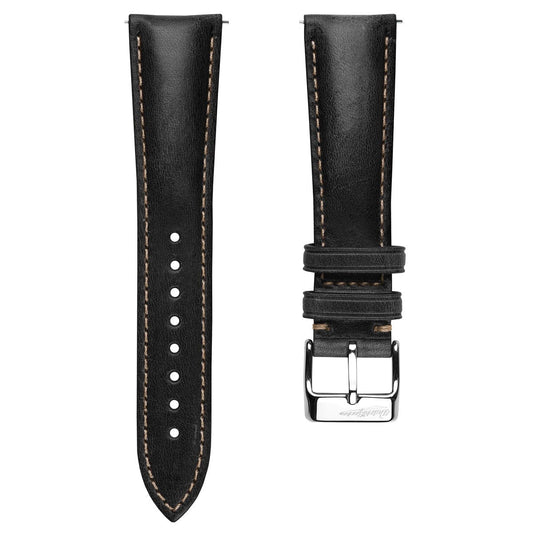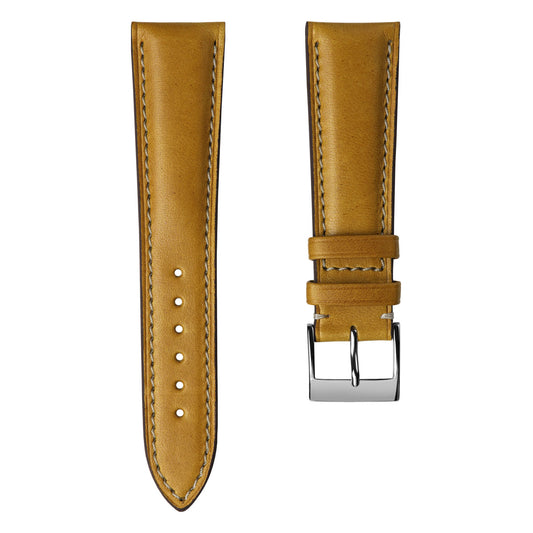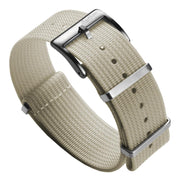The Christopher Ward C65 Dune Automatic is the perfect GADA watch, right? Unlike many true Go Anywhere, Do Anything watches, it has the ability (especially on a bracelet) to flirt with high-society functions thanks to its muted dial tones and under-the-radar sizing (38 mm diameter and 11.7 mm thickness). It’s price (£750) is borderline scandalous. Other watch brands must look at models like this from Christopher Ward and throw their hands up in exasperation. And so they should. When you have a highly-regarded maker of good quality and versatile watches operating a transparent business plan and throwing out enough references to keep almost every potential customer satisfied you have to bring your A-game to have a chance. Thankfully, though, the C65 Dune Automatic is so good, that it couldn’t possibly be improved upon, right?
Right?
Apparently, no one thought to tell Christopher Ward.
 Christopher Ward C65 Dune GMT on Original Vintage Highley Genuine Leather Watch Strap - Credit WatchGecko
Christopher Ward C65 Dune GMT on Original Vintage Highley Genuine Leather Watch Strap - Credit WatchGecko
- Regular price
- $128.00 CAD
- Regular price
-
- Sale price
- $128.00 CAD
- Unit price
- per

- Regular price
- $128.00 CAD
- Regular price
-
- Sale price
- $128.00 CAD
- Unit price
- per

- Regular price
- $128.00 CAD
- Regular price
-
- Sale price
- $128.00 CAD
- Unit price
- per

The release of the Christopher Ward C65 Dune GMT is not just a smart move commercially, it is also an excellent example of how to get the most out of an existing model line without having to reinvent the wheel.
The C65 Dune GMT is marginally thicker to accommodate for the GMT functionality of the Sellita SW330 utilised, but remains 38 mm in diameter. The oversized (and extremely handsome) crown remains. The sandy tones of the original tone stay put in the center of the dial but they are joined by a smoky olive green that changes the character of the watch entirely.
While I do think it’s fair to say that the addition of this deftly chosen accent colour transforms the character of the watch entirely, it does not lessen its impact in the slightest. In fact, I think it moves the Dune into an all-out adventure category at the expense of the Dune Automatic’s versatility. That is both a positive and a negative depending on where and how you want to wear this watch. For me, the military shade of green makes this watch appear tailor-made for the bush, but nowhere near as appropriate for the ballet. The subtleness of the original, sans-GMT version was its strength; here, however, with the additional GMT functionality and new colour scheme, its ruggedness becomes its most obvious trait.
 Christopher Ward C65 Dune Automatic on ZULUDIVER 1973 British Military Watch Strap: AIRBORNE Elastic - Credit WatchGecko
Christopher Ward C65 Dune Automatic on ZULUDIVER 1973 British Military Watch Strap: AIRBORNE Elastic - Credit WatchGecko
I would advise anyone reading this article to go to Christopher Ward’s website and open both product pages side by side. You can find the C65 Dune Automatic here and the C65 Dune GMT here. When you flip between the tabs, you will see that the exterior housing remains identical (despite the tech specs claiming the lug-to-lug length of the Automatic is 43.6 mm, 0.1 mm shorter than the listed 43.7 mm for the GMT — we’re pretty sure that’s just a typo, but, regardless, the watch is impressively compact). The dials, however, flip from the basic Automatic layout to the more hemmed-in display of the GMT. The green chapter ring makes the watch appear much smaller, but it is well integrated into the design thanks to the green tip of the broad arrow GMT indicator hand.
Otherwise, the components remain almost identical (with the exception of a noticeably shorter minute hand to allow space for the peripheral chapter ring). The minute markers creep into the center of the dial, abandoning their old stations around the edge of the display. While this adds to the visual shrinkage of the piece, it doesn’t have an uncomfortably huddling effect on the dial furniture positioning. In fact, despite there being a lot more going on in exactly the same amount of space, the Christopher Ward C65 Dune GMT retains a serenely proportioned layout.
Perhaps the oddest thing about these two almost identical watches is how different they are from one another. I spent a lot of time with both pieces prior to writing this article and imagined at the outset of the task I would come away with a clear favourite, but alas, I am totally torn between the two.
 Christopher Ward C65 Dune GMT on Laverton Padded Alcantara Handmade Watch Strap - Credit WatchGecko
Christopher Ward C65 Dune GMT on Laverton Padded Alcantara Handmade Watch Strap - Credit WatchGecko
- Regular price
- $260.00 CAD
- Regular price
-
- Sale price
- $260.00 CAD
- Unit price
- per

- Regular price
- $260.00 CAD
- Regular price
-
- Sale price
- $260.00 CAD
- Unit price
- per

- Regular price
- $260.00 CAD
- Regular price
-
- Sale price
- $260.00 CAD
- Unit price
- per

Mad as it may seem to suggest, I even believe there is justification for owning both. While the rank similarities of the pieces would suggest it makes the most sense to buy one and not the other, I think their applications and characters are sufficiently different from one another and the overall aesthetic is sufficiently different from almost everything else on the market (and at this price point) that you could actually justify it.
If I was pushed to choose, I might lean towards the GMT despite it being the less versatile of the pair. Why? Because I have many watches and don’t need one watch to do everything and because of the two, I feel the GMT is the more ambitious (and successful) model, thanks to its seldom-seen colourway and its effective integration with the dial and its functionality (while it is aesthetically beneficial for the GMT hand to share the same shade of green as the chapter ring to pull the accent colour into the middle of the design, it is also a linking mechanism for these two additional elements that facilitates their use).
If buying both the Dune Automatic and the Dune GMT (which is, of course, also an automatic), is a bit too crazy for you, then perhaps consider picking up the Dune GMT and then furnishing your watch box with a similarly sandy time-only model from either Baltic (the Hermetique) or Laventure (if you’re able to pick up one of the sought-after Marine II models that now sell for almost double their original retail price on the secondary market).




Christopher Ward C65 Dune Automatic on Variety of Straps from WatchGecko - Credit WatchGecko
What writing this review has convinced me of is that we need more beige in our lives. The olive can stick around too, if it likes, but the beige is paramount. Perhaps beige is the industry’s natural successor to salmon? Another colour nobody thought we needed on a watch dial until we all realised we did. And desperately.
Although I understand the way most watches are priced (intimately in many cases), the Christopher Ward business model does make it hard to argue with anything the brand does and hard not to question everything else everyone else does. CW has thrived without retailers and built a reputation as not just an A1 imitator, but also a top-class innovator with models like the Bel Canto and the recently released Twelve X. I mention those pieces at the conclusion of this review because of the effect they had on the brand’s prestige and the broader perception of what Christopher Ward is and what it will become is incredibly important when having the value discussion.
Five years ago, you could easily have pointed to similarly priced models from Hamilton, Certina, or Longines, for example, and argued that would always edge everything CW ever did because of the name on the dial. That’s no longer the case. While major entry-level luxury brands like those and those like them still have heritage and prestige on their side, Christopher Ward has become a dynamic leader in this space and doesn’t look like it wants to set down that mantel anytime soon. That can give you more confidence than ever before in your purchase from Britain’s leading light the in accessible watchmaking sphere, and has me repeating the same question over and over to myself:
I need them both, right?








